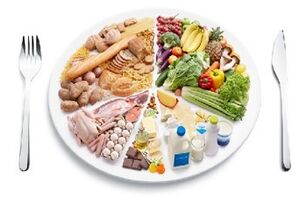
The diet for pancreatitis depends on whether the disease is acute or chronic. Don't forget that inflammation of the pancreas is not a trivial matter, because it plays an important role in the digestion, metabolism and assimilation of substances (proteins, carbohydrates and fats). Therefore, after the diagnosis is made, the diet must be changed immediately. Otherwise, even the latest generation of drugs will be powerless.
Acute (reactive) pancreatitis
As the name implies, the disease will happen suddenly (usually immediately after eating irritating food). Symptoms: abdominal burning, fever, nausea, vomiting. Risk factors: lack of protein in the diet, overeating, alcoholism, smoking, fat, spicy, fried, too cold or too hot food, sweet soda. Sometimes the disease is the result of gallstone disease and chronic cholecystitis.
The nutrition for acute (reactive) forms of pancreatitis in adults and children is designed to ensure maximum rest from prolonged pancreatic torment, while reducing pancreatic and stomach secretions. This is the sequence of actions the patient should take:
- The first 2-4 days after deterioration.It is recommended not to eat at all, but to use medicinal mineral water in small amounts.
- From the 5th day.Gradually, we expanded the pancreatitis diet menu very carefully. For this reason, it is recommended to stick to the 5P treatment table.
- 6-7 days.We add jelly, slimy soup, kefir, rice porridge (except millet), steamed chicken, beef and fish steak, mashed potatoes and other cooked and stewed vegetables, weak tea, Roasted or mashed apple, rosehip broth.
The function of the diet and sample menu
No matter where the patient is sent for pancreatitis treatment-to a nursing home or home, he should follow the fifth diet, which is based on the following principles:
- The daily intake of vegetable protein-30 grams, animal protein-50 grams, vegetable fat-15 grams, animal fat-45 grams, carbohydrate-200 grams, the total caloric intake of pancreatitis should not be taken every dayMore than 2500-2700 kcal. The amount of liquid you drink is 1. 5 liters, and the amount of salt is 10 grams.
- In the first two weeks, we cooked unsalted dishes.
- In order to reduce the risk of overeating, we eat at least 5-6 times a day.
- The temperature of the prepared food should be between 45 and 60 degrees.
- The consistency of the dishes is liquid, semi-liquid, that is, only puree.
The acute pancreatitis diet has completely excluded smoked meat, fried foods, pickles and pickles, sour cream, lard, canned food, baked goods and fresh bread, butter for a long period of time (nearly a year), alcohol. Following all the recommendations above can prevent the development of chronic diseases! The sample menu for the day might look like this:
- Breakfast:Steam omelet, boiled into gruel and thin tea.
- Second breakfast:Cheese and milk.
- Lunch:Buckwheat soup, stew, apple jelly.
- Dinner:Steamed fish steak, carrot puree, rosehip broth.
- Evening:Kefir.
Chronic pancreatitis
This disease has another extremely unattractive name-prediabetes. Indeed, if you have passed the acute phase disadvantageously (without proper treatment), the next step may be diabetes. The disease is characterized by two alternating stages-worsening and remission. Therefore, the nutrition of pancreatitis aims to alleviate the inflammatory process, thereby turning the disease into remission.
Therefore, from now on, your diet will become a lifelong nutritional system. And there is nothing you can do. You can still base on the No. 5 diet, and we will continue to strictly abide by its basic principles. Diet aggravated the onset of chronic pancreatitis and returned to the first three steps (fasting mineral water and further fasting according to the above list).
Approved products:
- Milk, yogurt, kefir, sour cheese, mild cheese;
- Porridge (buckwheat, oats, rice), pasta;
- Vegetables (potatoes, carrots, pumpkins, zucchini, beets, etc. );
- Wheat crackers or old white bread;
- Meat (beef, chicken, rabbit, turkey), lean fish;
- Baked apples, jelly, berry gravy;
- Oatmeal soup, fruit drink, non-acid juice, chamomile tea;
- Vegetable soup and miso soup, celery juice.
Prohibited products:
- Sour fruit, fresh cabbage, beans;
- Spinach, sorrel, turnip, turnip;
- Spices and herbs;
- Fresh bread, pastries, sweets;
- Sausage, smoked meat, canned food, eggs;
- Meat, fish soup, cabbage soup, borscht;
- Alcohol, sweetened beverage with gas;
- Candies, ice cream, sour cream, cream;
- Fried food.






























